Technics SL-1200/1210 Pitch Slider Replacement and Adjustment
by krakpot in Circuits > Audio
60817 Views, 26 Favorites, 0 Comments
Technics SL-1200/1210 Pitch Slider Replacement and Adjustment
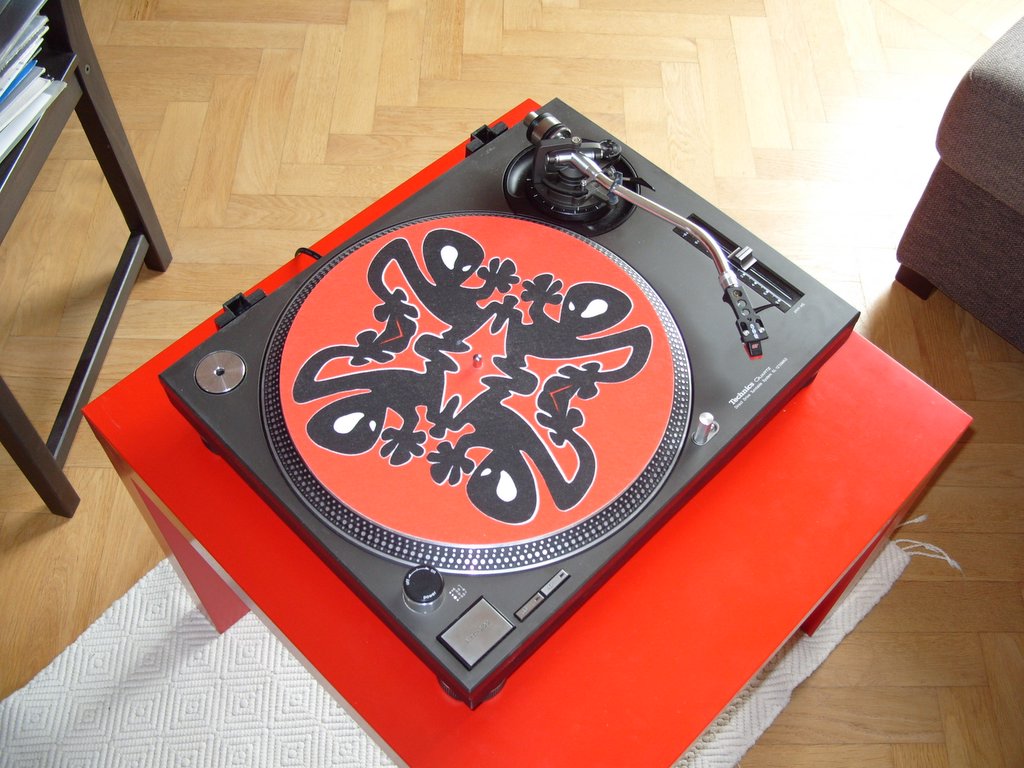
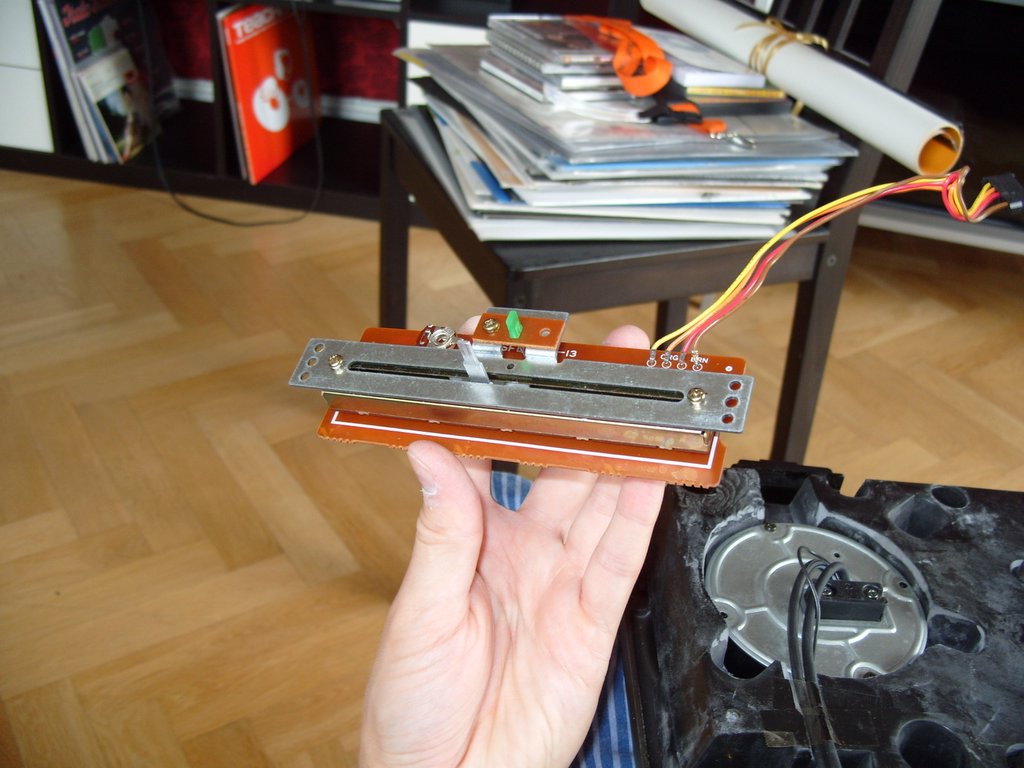
So your pitch slider feels like it's full of sand? Time to fix it. This instructable will demonstrate how to replace a worn out pitch slider on a Technics SL-1200/1210 turntable. It will also show how to adjust +6% pitch value if it has drifted or if the new slider has different properties than the original one. I've also added a new shading cloth as the one in my 1210 turned to dust when it was touched.
The most important thing is to remember to DISCONNECT THE TURNTABLE FROM MAINS POWER at all times before the platter is removed! This is both for your own safety and the fact that the motor can be damaged if it's accidentally turned on while the platter is removed.
I bought my new pitch slider from a shop on ebay.co.uk for around GBP 13 and the shading cloth was GBP 2.50 from the same place.
This will probably take an hour or so depending on how handy you are with the soldering iron and desoldering wick.
The information in this Instructable is information I've picked up from several different text based instructions on the net (Technics SL-1200Mk2/SL-1210Mk2 FAQ from hyperreal.org and several more I have not saved). I thought it would be a good idea to document it with pictures for you guys as I was replacing a slider anyhow.
Please note that you do this on your own risk. I've done all steps here several times without any problems. If you damage your turntable or get shocked or similar I am not responsible. If you don't think you are competent enough or your turntable is still under warranty, let a professional do this.
The most important thing is to remember to DISCONNECT THE TURNTABLE FROM MAINS POWER at all times before the platter is removed! This is both for your own safety and the fact that the motor can be damaged if it's accidentally turned on while the platter is removed.
I bought my new pitch slider from a shop on ebay.co.uk for around GBP 13 and the shading cloth was GBP 2.50 from the same place.
This will probably take an hour or so depending on how handy you are with the soldering iron and desoldering wick.
The information in this Instructable is information I've picked up from several different text based instructions on the net (Technics SL-1200Mk2/SL-1210Mk2 FAQ from hyperreal.org and several more I have not saved). I thought it would be a good idea to document it with pictures for you guys as I was replacing a slider anyhow.
Please note that you do this on your own risk. I've done all steps here several times without any problems. If you damage your turntable or get shocked or similar I am not responsible. If you don't think you are competent enough or your turntable is still under warranty, let a professional do this.
Removing the Platter

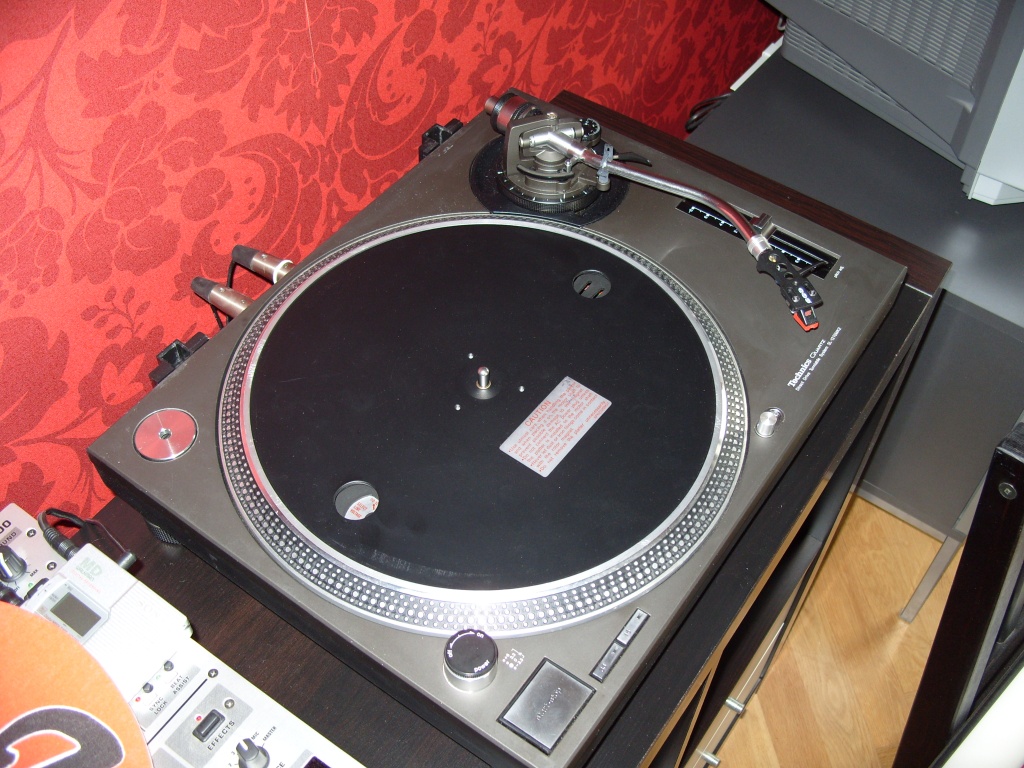
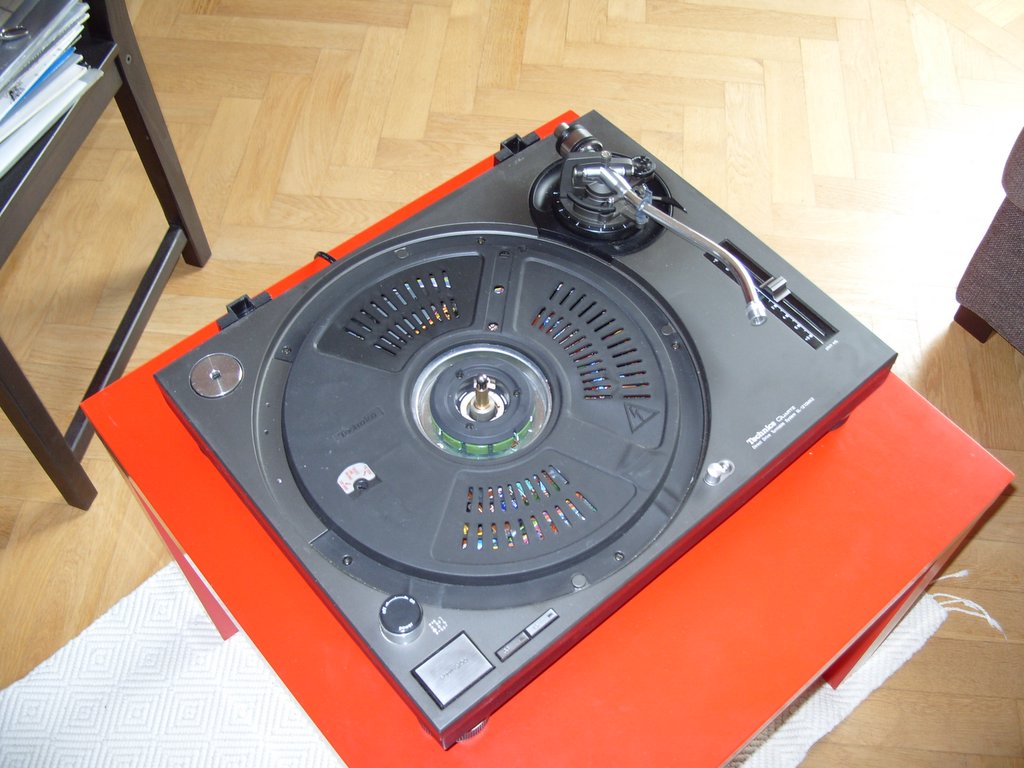
Disconnect the turntable from mains power before doing anything further.
Remove your pickup from the tone arm to prevent any damage to it.
Remove the slipmat and you will uncover the platter which you will see two holes in. Place your thumbs in these holes, grabbing the platter from the underside with the tips of your thumbs. Push with the other fingers on the outside of the platter. The platter will move a bit upwards and then you will think it's stuck, pull some more with your thumbs and the platter will then snap loose. Place the platter in a safe place where it will not be damaged or fall to the floor.
Remove your pickup from the tone arm to prevent any damage to it.
Remove the slipmat and you will uncover the platter which you will see two holes in. Place your thumbs in these holes, grabbing the platter from the underside with the tips of your thumbs. Push with the other fingers on the outside of the platter. The platter will move a bit upwards and then you will think it's stuck, pull some more with your thumbs and the platter will then snap loose. Place the platter in a safe place where it will not be damaged or fall to the floor.
Opening the Turntable

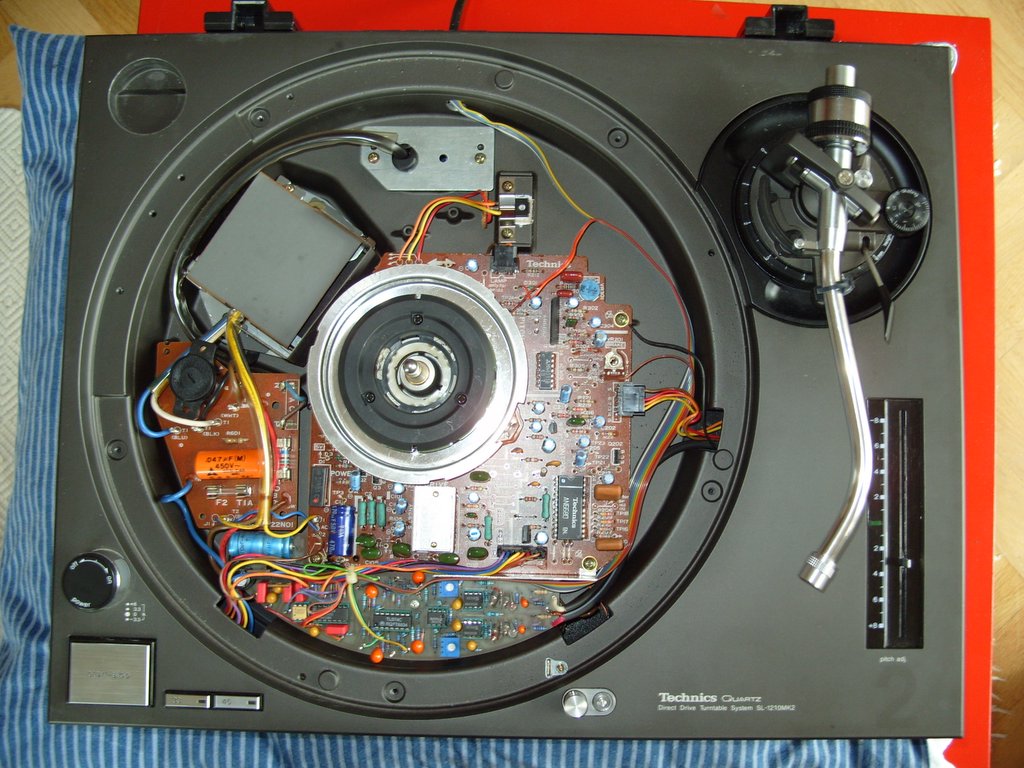
Remove the five phillips head screws from the circular area under the turntable. Notice how they look and store these in a safe place.
Make sure mains power is disconnected as there power supply is under this cover. Lift the cover. Please do not touch the power supply on the left side as the capacitors might still be charged and give you a shock.
In fact it's probably better that you touch the PCB as little as possible to prevent any damage from static electricity.
Disconnect the small pitch slider connector on the right side of the PCB.
Remove the pitch slider handle and take care of the little circular piece of cloth that is seated on the pitch slider arm.
Make sure mains power is disconnected as there power supply is under this cover. Lift the cover. Please do not touch the power supply on the left side as the capacitors might still be charged and give you a shock.
In fact it's probably better that you touch the PCB as little as possible to prevent any damage from static electricity.
Disconnect the small pitch slider connector on the right side of the PCB.
Remove the pitch slider handle and take care of the little circular piece of cloth that is seated on the pitch slider arm.
Removing the Bottom
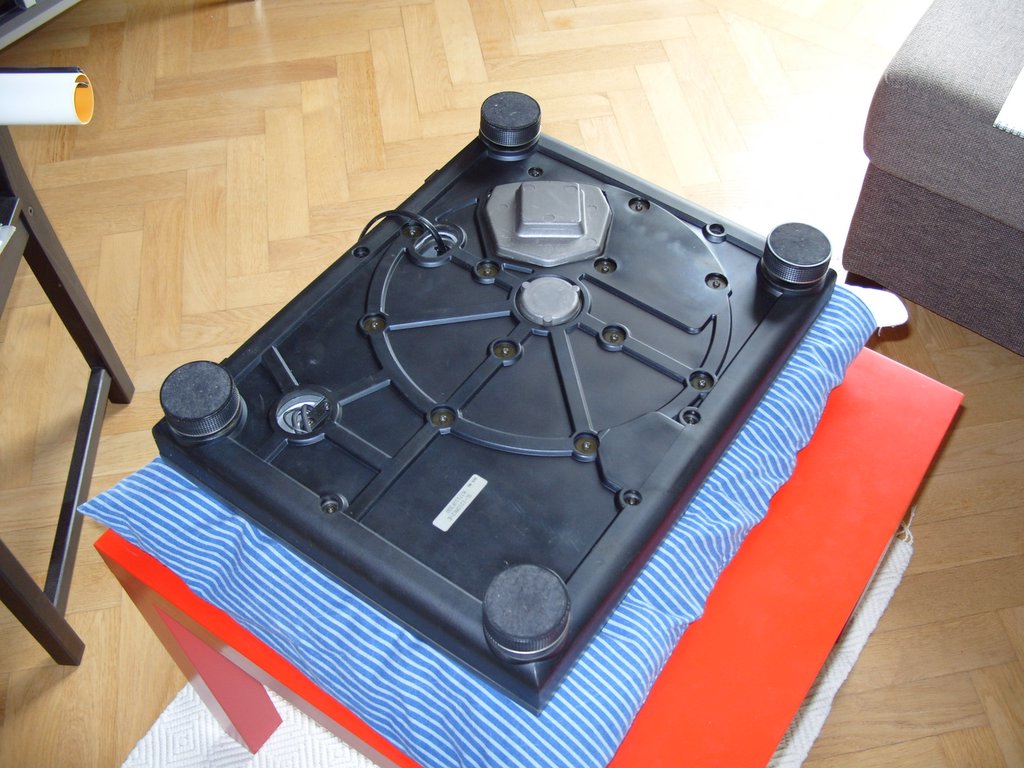
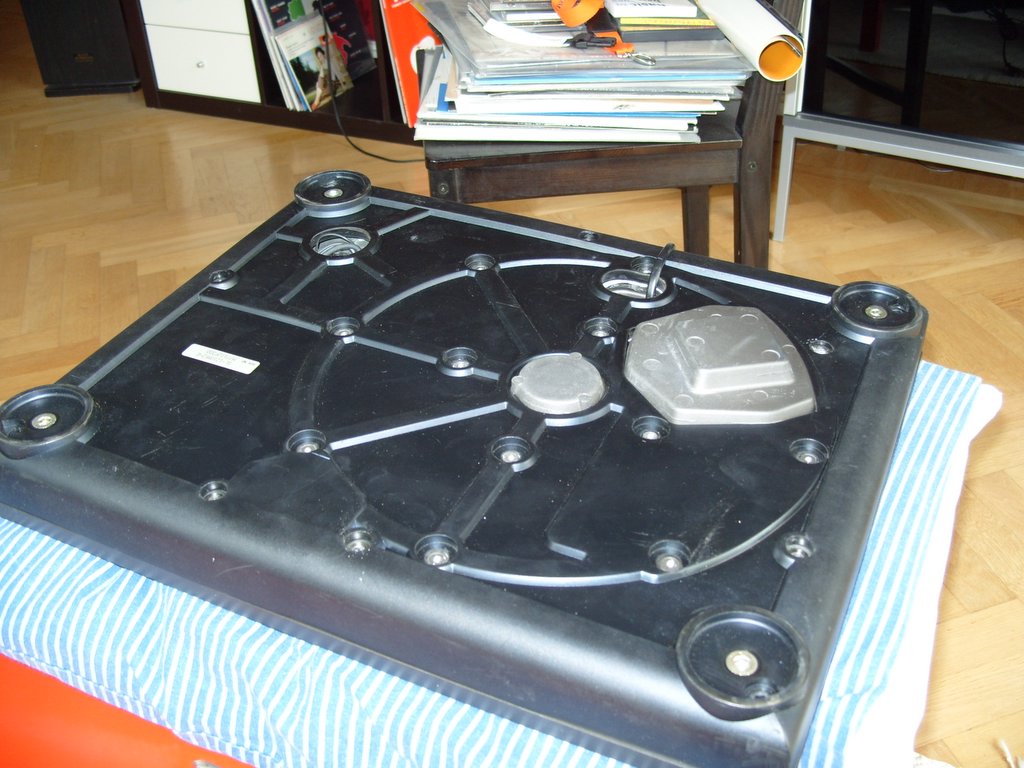
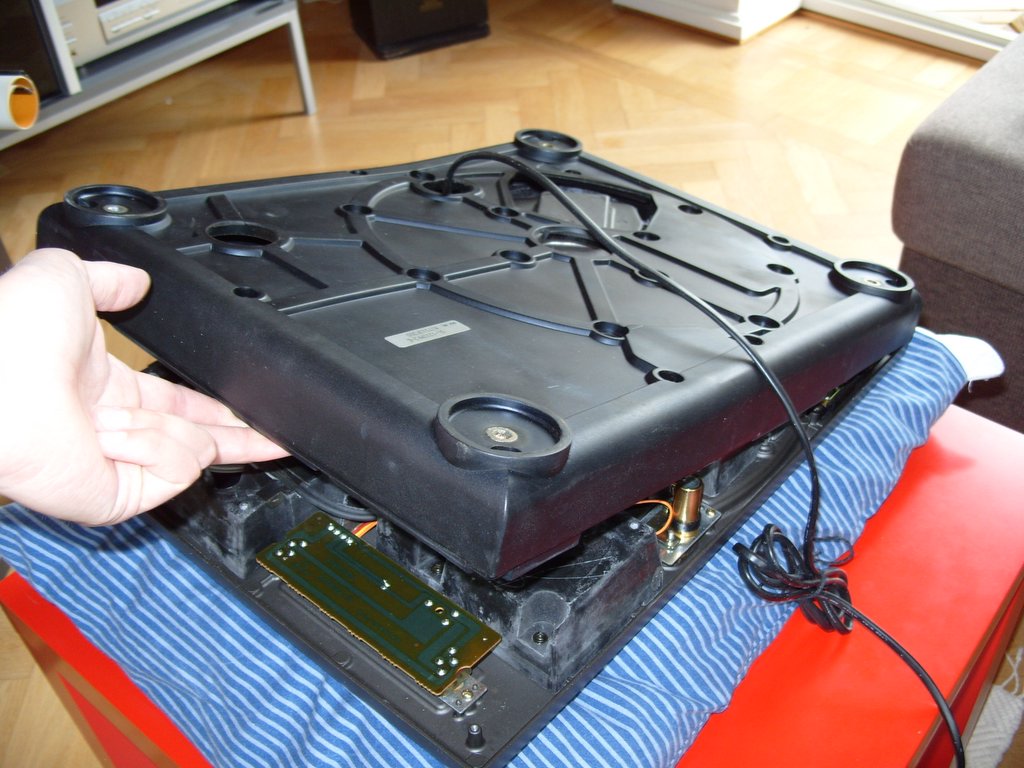
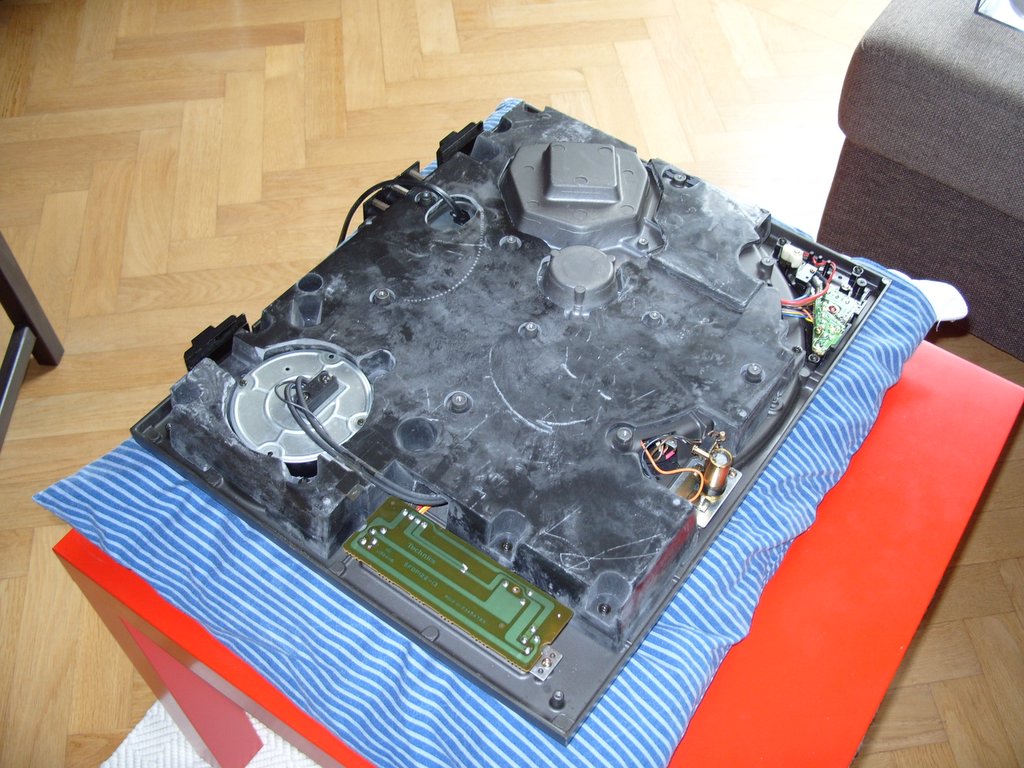
Ok. Time to flip the turntable over to remove the bottom. To prevent damage to the tonearm you can replace the dust cover and let the turntable rest on this. It's possible though that the dustcover will be scratched or maybe cracked when doing this. Another option is using some kind of sturdy box about the same size as the turntable. I've used a soft pillow in these pictures. It's probably not the best option but's it worked fine for me.
Make sure you've removed your 7" aluminium puck from the turntable before turning it over and placing it on it's back (on the dustcover, a pillow or something else protecting the tone arm).
Unscrew the four feet by twisting them like a regular screw. Remove all screws (don't forget the screws located under the feet). Please make a note of which screws that go where as there are three different types and store them separately.
Double check that all screws are removed and then try to get a grip of the bottom by placing your nails between the bottom and the top. The bottom is made of a relatively soft rubber or plastic material so it will flex a little. It will take some force to remove it. Let the cable slide through the hole in the bottom so you can remove the bottom entirely.
Make sure you've removed your 7" aluminium puck from the turntable before turning it over and placing it on it's back (on the dustcover, a pillow or something else protecting the tone arm).
Unscrew the four feet by twisting them like a regular screw. Remove all screws (don't forget the screws located under the feet). Please make a note of which screws that go where as there are three different types and store them separately.
Double check that all screws are removed and then try to get a grip of the bottom by placing your nails between the bottom and the top. The bottom is made of a relatively soft rubber or plastic material so it will flex a little. It will take some force to remove it. Let the cable slide through the hole in the bottom so you can remove the bottom entirely.
Removing the Pitch Slider


Unscrew the two phillips head screws at the top and the bottom of the pitch slider PCB. Notice that on the top there is a small grounding cable that is fastened with the screw.
If the pitch slider has not been replaced earlier the cable (You did disconnect the pitch slider cable in step 2 didn't you? Otherwise you will have to go back) going to the main PCB will probably be fastened in a small metallic spiral. You will have to unwind the cable from this before you can get the slider PCB loose, but do not just pull it! If the slider's been replaced earlier it's possible that it's not fastened as it's a bit of a hassle to do without opening the turntable even more.
Now you should be able to remove the pitch slider PCB.
If the pitch slider has not been replaced earlier the cable (You did disconnect the pitch slider cable in step 2 didn't you? Otherwise you will have to go back) going to the main PCB will probably be fastened in a small metallic spiral. You will have to unwind the cable from this before you can get the slider PCB loose, but do not just pull it! If the slider's been replaced earlier it's possible that it's not fastened as it's a bit of a hassle to do without opening the turntable even more.
Now you should be able to remove the pitch slider PCB.
Desoldering the Old Slider
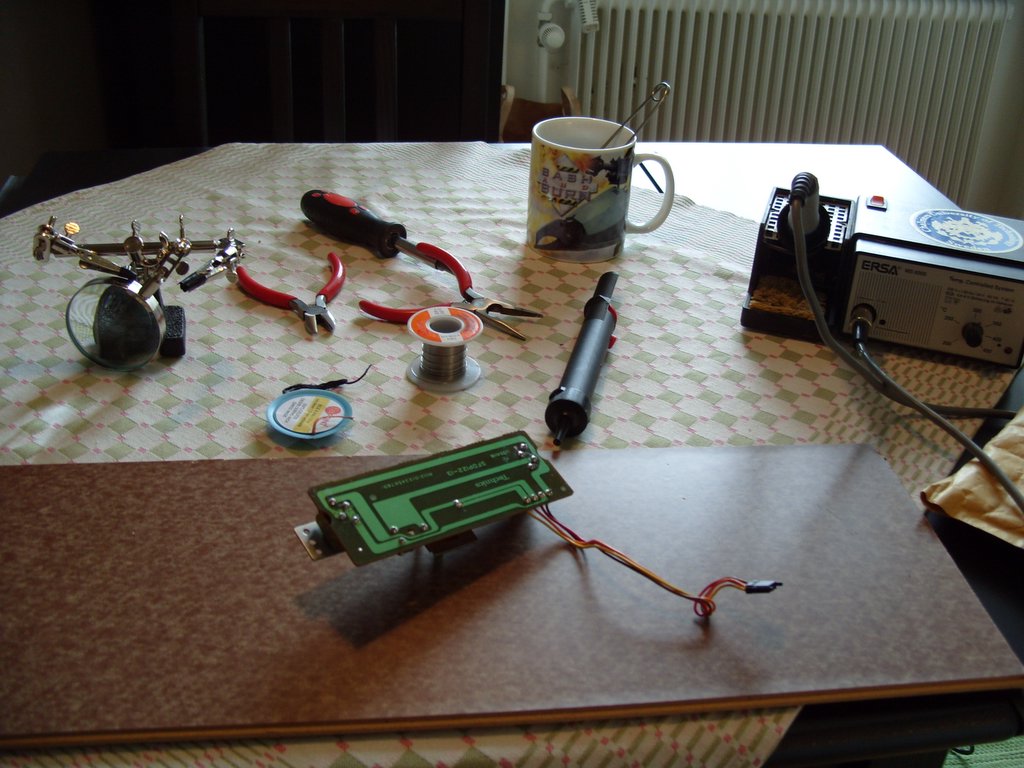
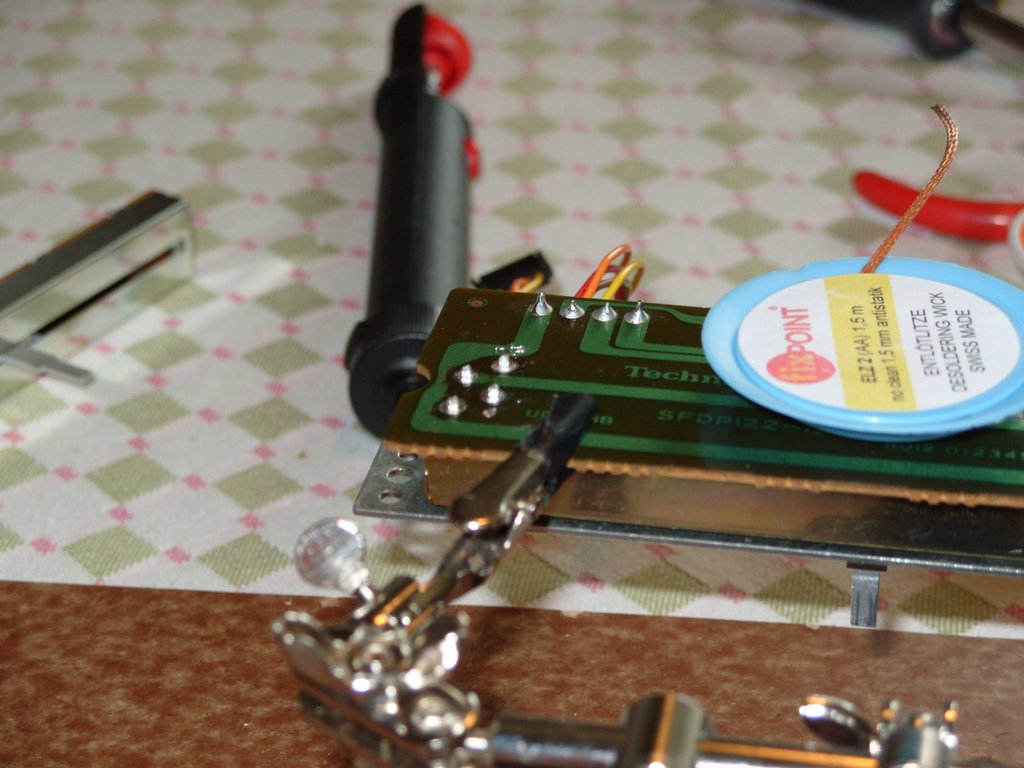
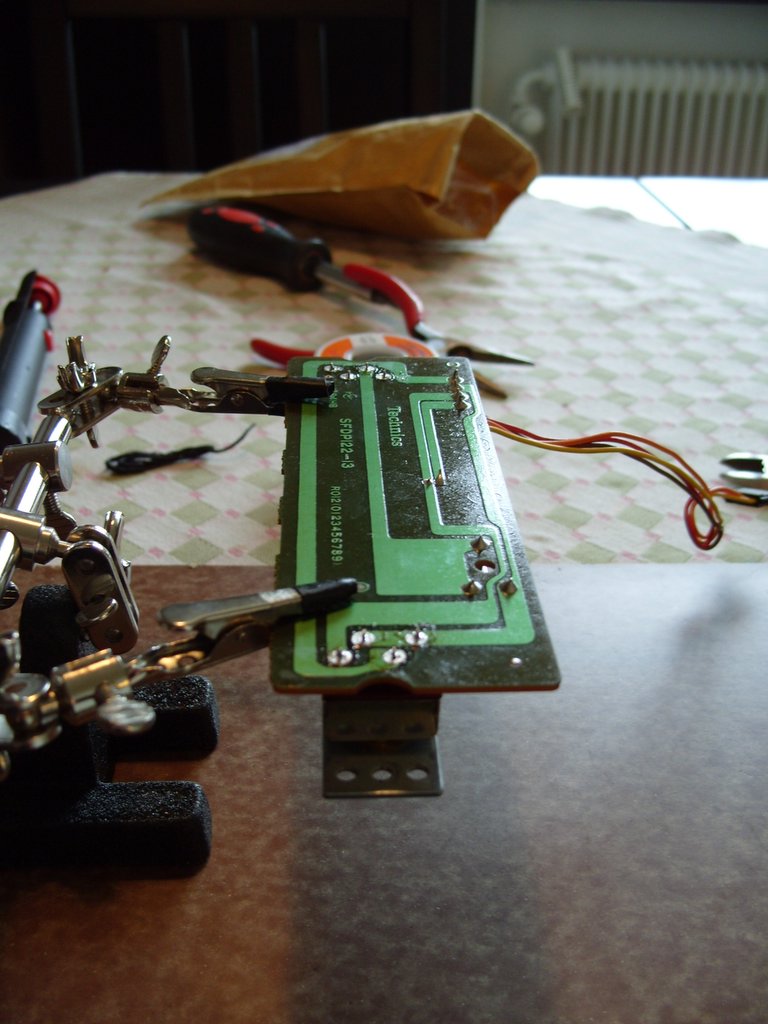
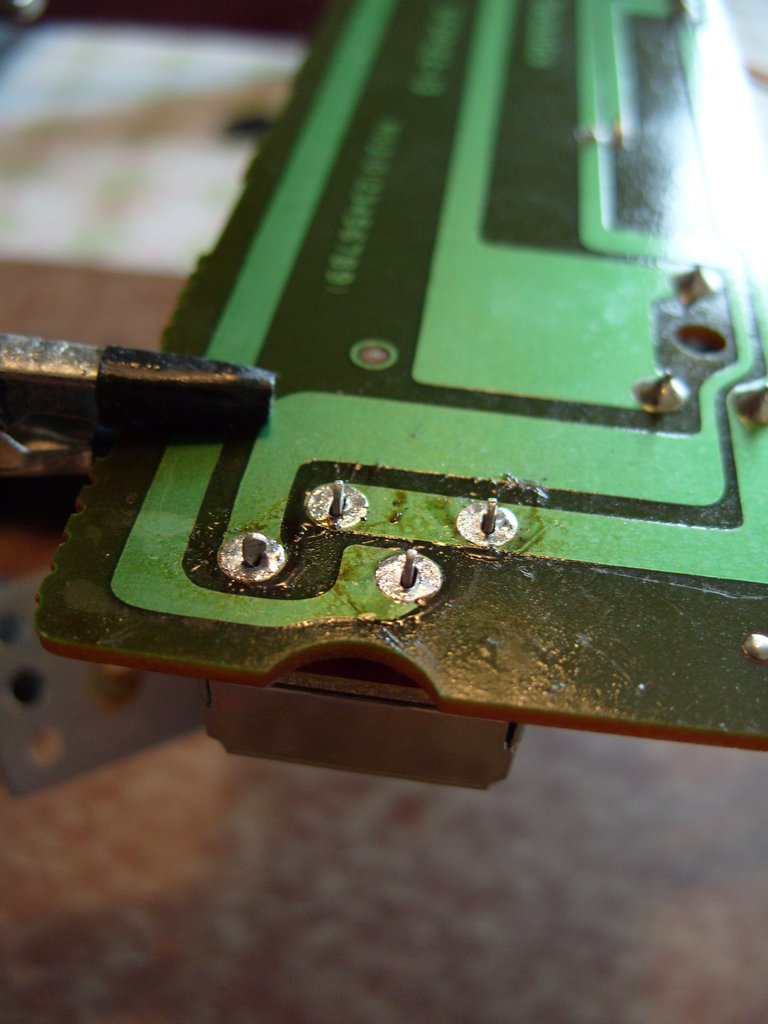
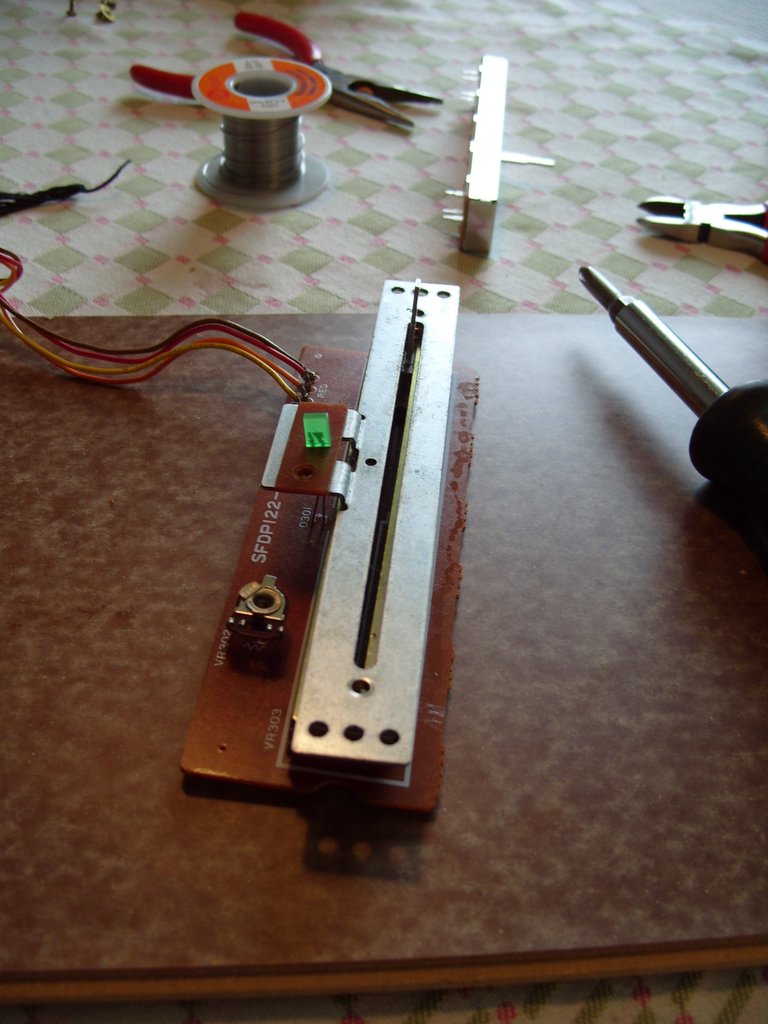
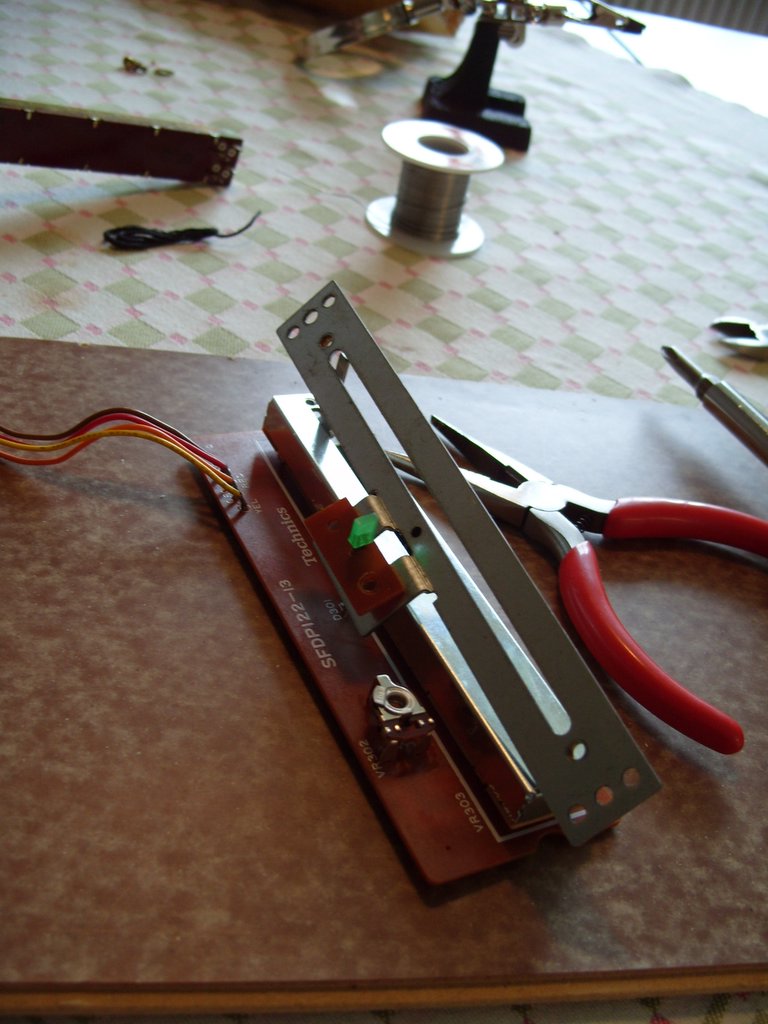
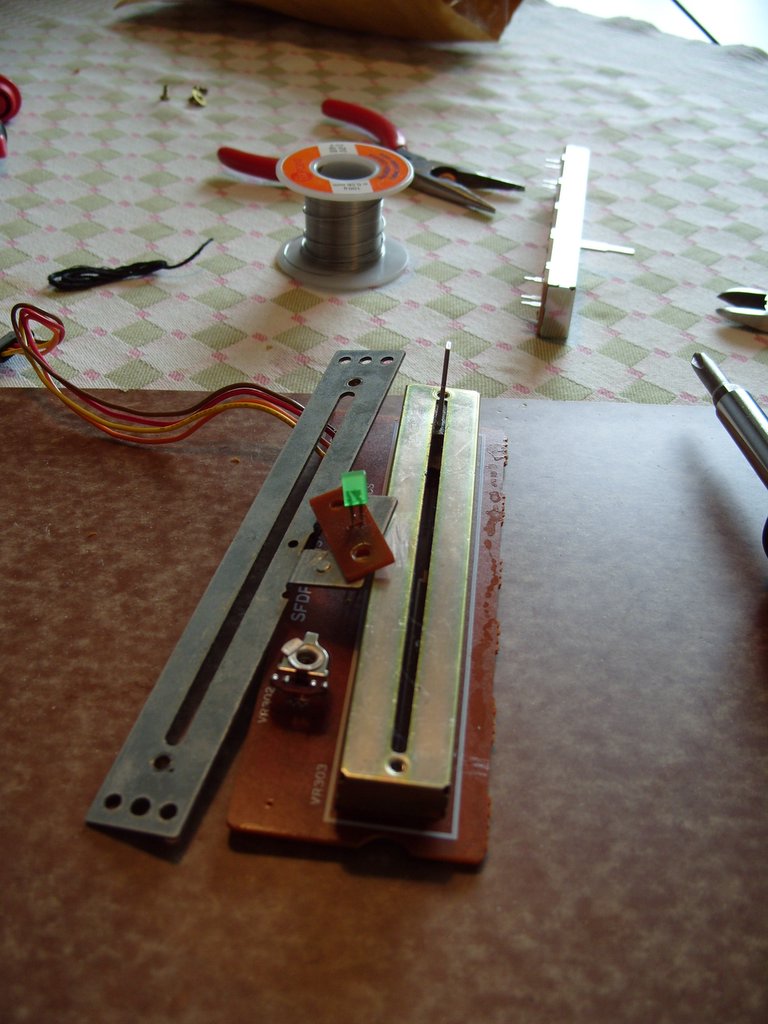
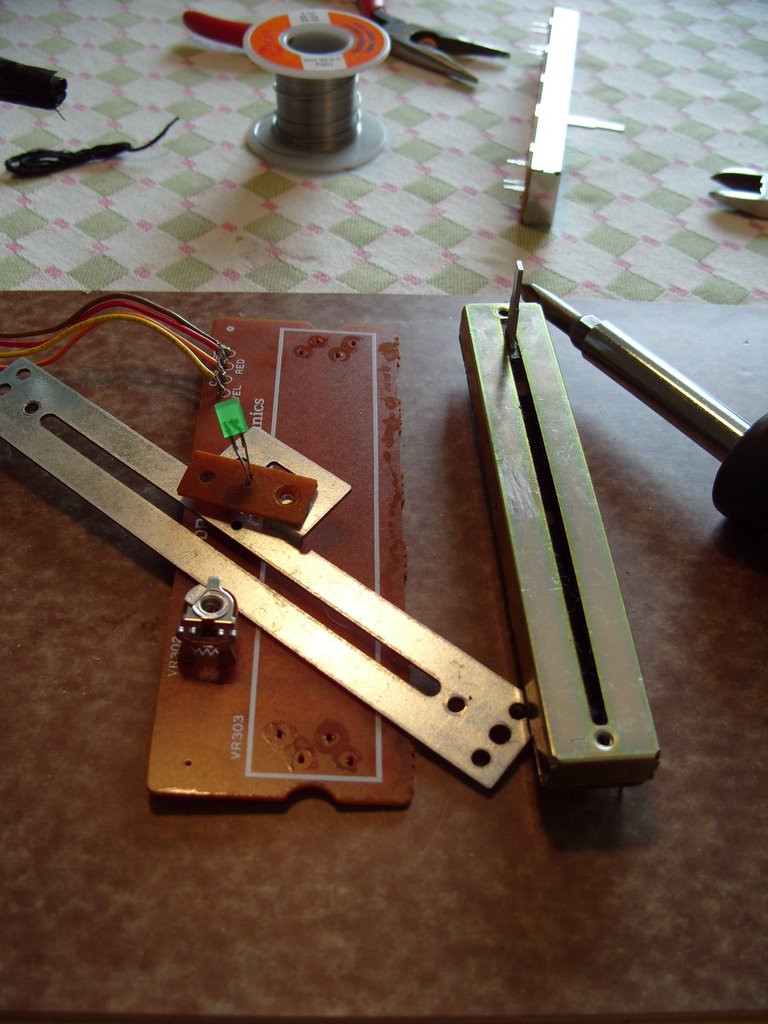
Time to get busy with the soldering iron! It's a great help to have a "helping hand" here, either a friend or and artificial one :-)
Use desoldering wick on the top and bottom four solder points on the PCB. If this is a factory installed slider it's possible that the legs going through the PCB are twisted to hold the slider in place. Untwist these carfully with a pair of crocodile pliers to be able to remove the slider later on.
When all the solder is removed from the eight legs, turn the PCB over. Remove the phillips head screws from the top and the bottom of the slider. Also remove the one beside the LED (don't let the little washer that is placed between the epoxy board and the metal get lost). Now you have two options, either you desolder the LED to be able to get the metal out of the way. I think this is too much work so another option is to slide the pitch to the top of the slider and carefully lift the metal off the slider. Be careful, you will probably bend the LED a little but it should be OK.
If you were really lucky with the desoldering wick you can now remove the pitch slider from the PCB. But if you're like me you probably can't. Grab the slider with your fingers and turn the PCB over. Try to push your fingers, carefully, between the PCB and the slider while heating the legs one at a time with the soldering iron. If it's not working, make sure you actually untwisted all of the legs!
By now the slider and the PCB should be separate entities :-)
Use desoldering wick on the top and bottom four solder points on the PCB. If this is a factory installed slider it's possible that the legs going through the PCB are twisted to hold the slider in place. Untwist these carfully with a pair of crocodile pliers to be able to remove the slider later on.
When all the solder is removed from the eight legs, turn the PCB over. Remove the phillips head screws from the top and the bottom of the slider. Also remove the one beside the LED (don't let the little washer that is placed between the epoxy board and the metal get lost). Now you have two options, either you desolder the LED to be able to get the metal out of the way. I think this is too much work so another option is to slide the pitch to the top of the slider and carefully lift the metal off the slider. Be careful, you will probably bend the LED a little but it should be OK.
If you were really lucky with the desoldering wick you can now remove the pitch slider from the PCB. But if you're like me you probably can't. Grab the slider with your fingers and turn the PCB over. Try to push your fingers, carefully, between the PCB and the slider while heating the legs one at a time with the soldering iron. If it's not working, make sure you actually untwisted all of the legs!
By now the slider and the PCB should be separate entities :-)
Attaching the New Slider

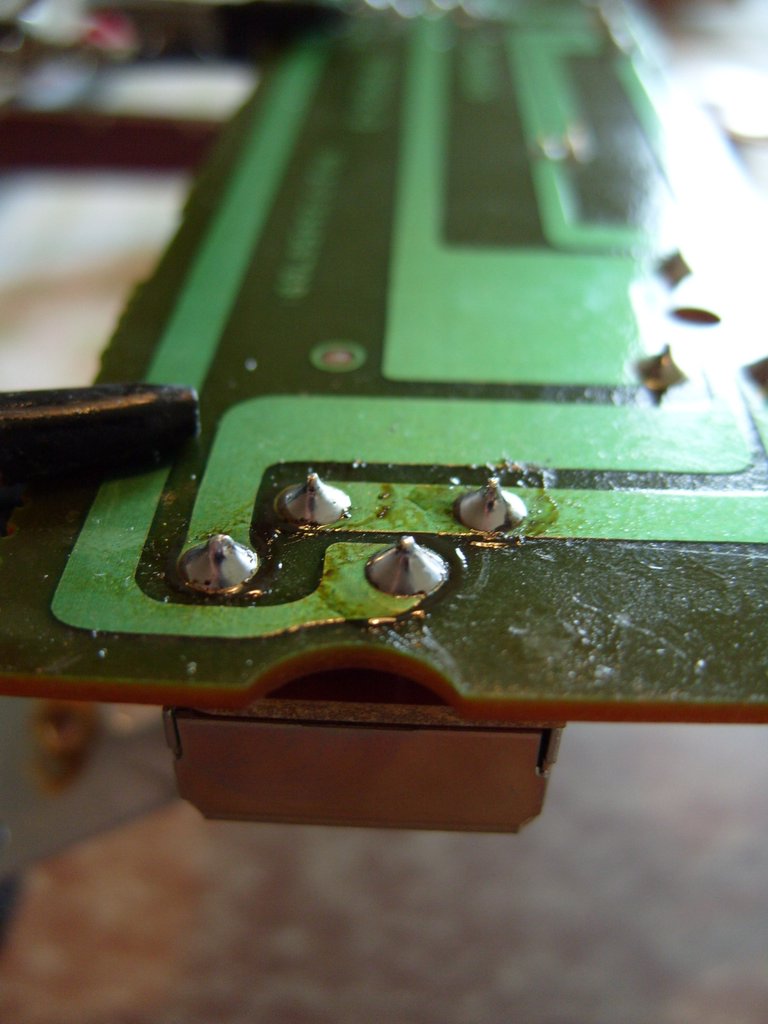
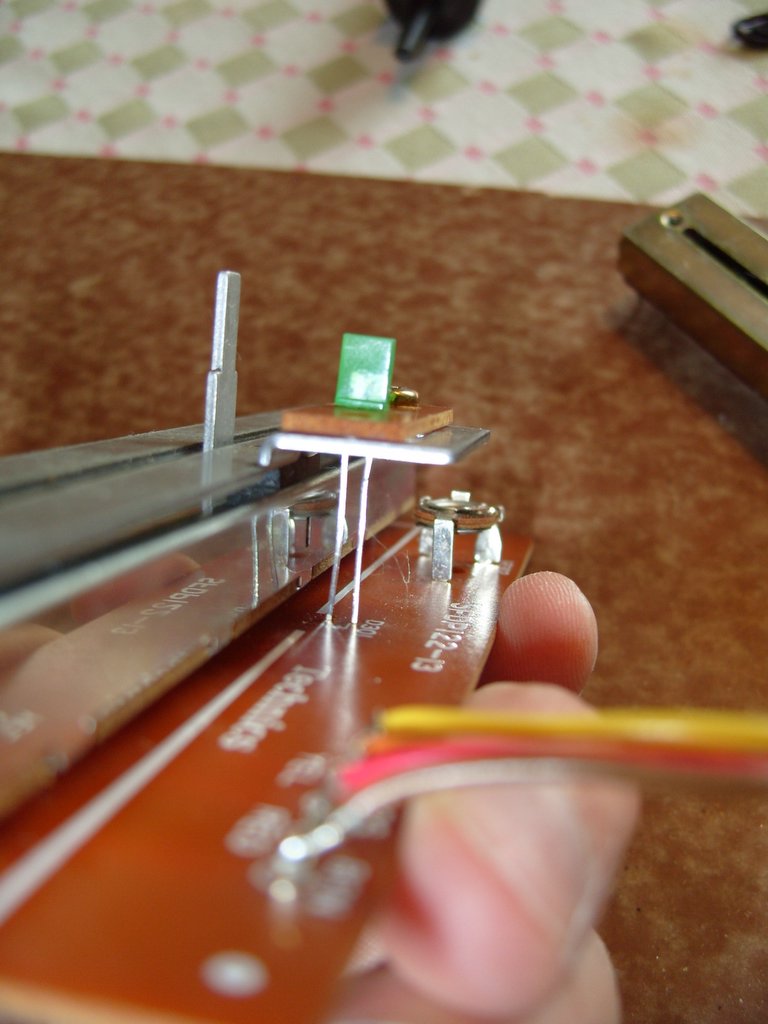
Insert your new pitch slider in the holes where the old one was seated. It's only possible to mount it one way, make sure all legs go though the holes and that none are bent. If you can not get all legs trough there's probably too much solder left in the holes.
Make sure all legs go in as far as possible. To make sure the the slider stays seated while soldering you can twist some or all of the legs slightly. Solder all eight legs properly.
Turn the PCB over and twist the metal sheet back to the original location. If you did not desolder the LED; make sure the two legs do not touch each other.
Replace all three screws, don't forget to replace the metallic washer between the epoxy and metal when reseating the LED screw.
Make sure all legs go in as far as possible. To make sure the the slider stays seated while soldering you can twist some or all of the legs slightly. Solder all eight legs properly.
Turn the PCB over and twist the metal sheet back to the original location. If you did not desolder the LED; make sure the two legs do not touch each other.
Replace all three screws, don't forget to replace the metallic washer between the epoxy and metal when reseating the LED screw.
Replacing the Shading Cloth (not Mandatory)
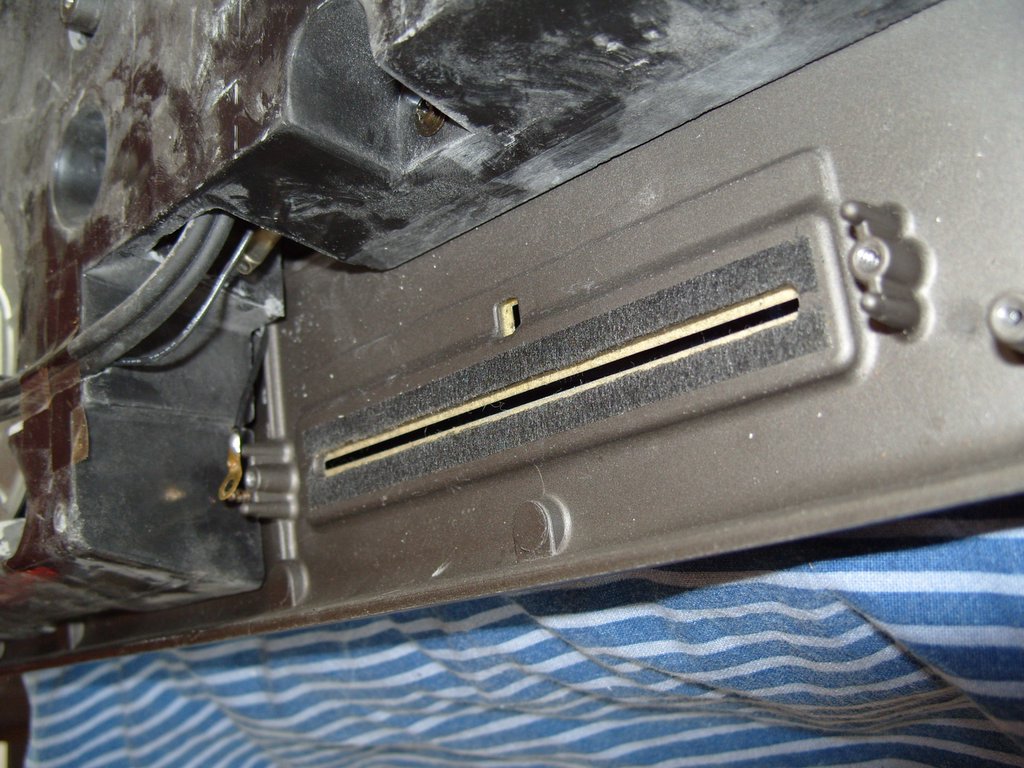
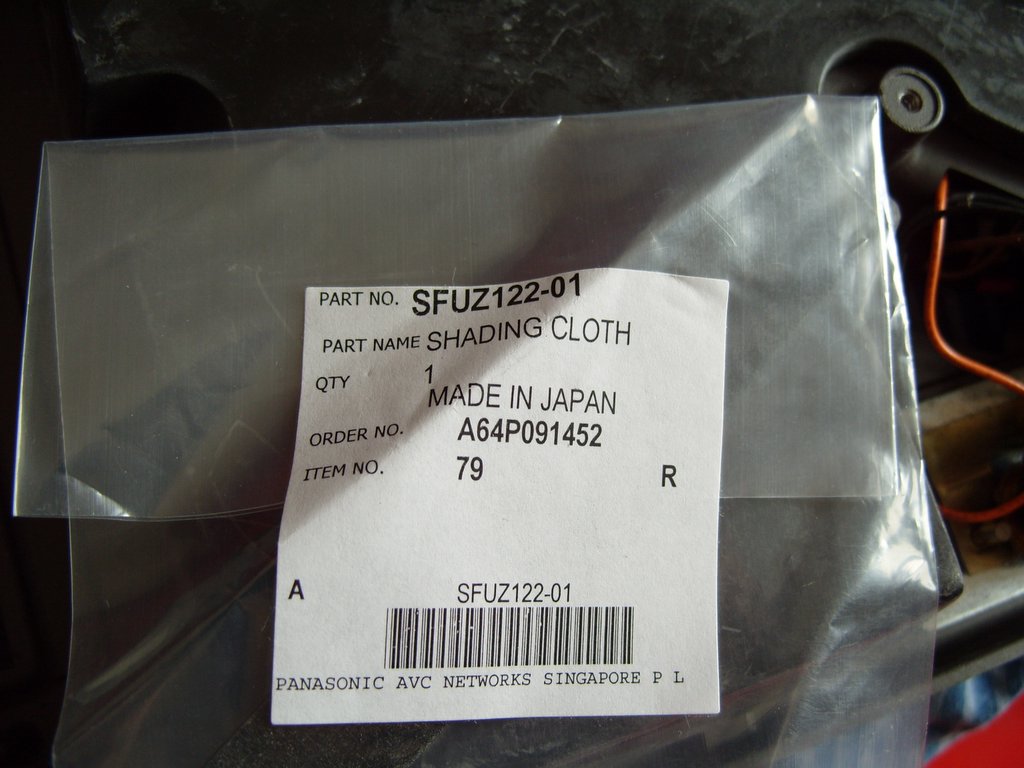
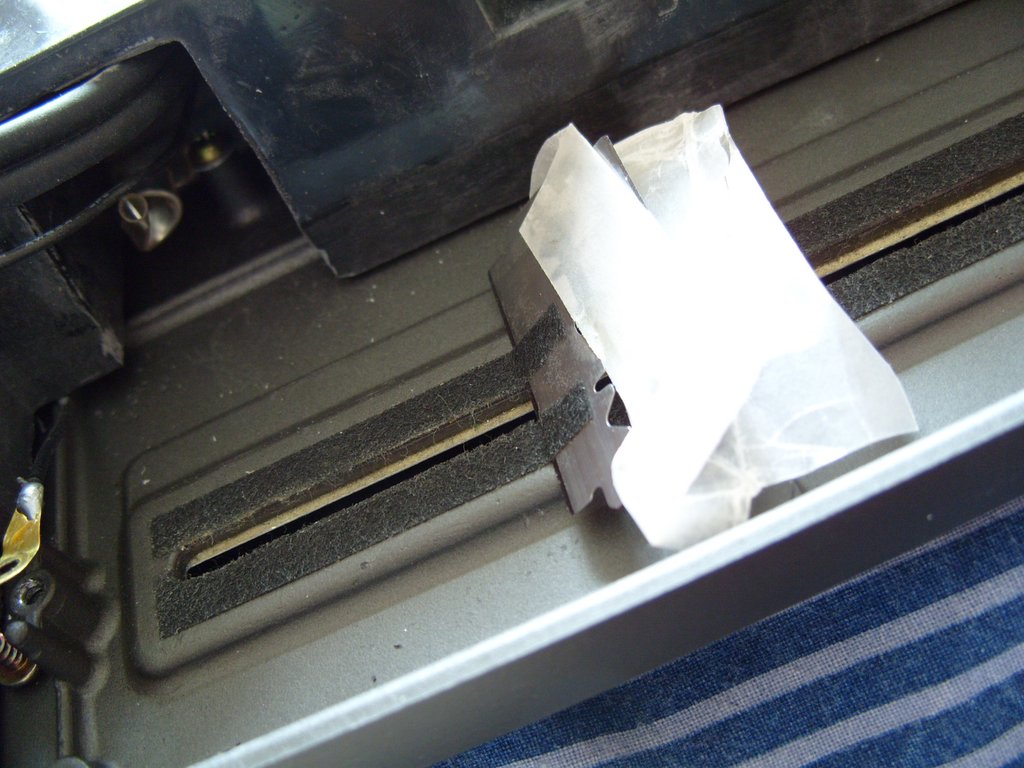
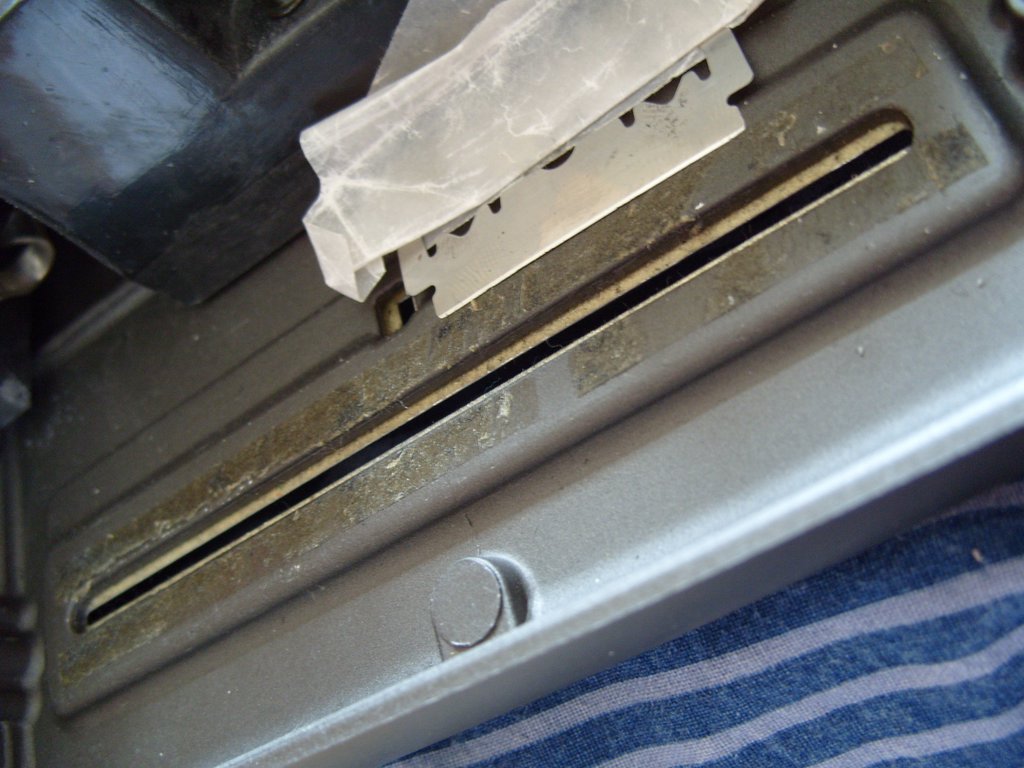
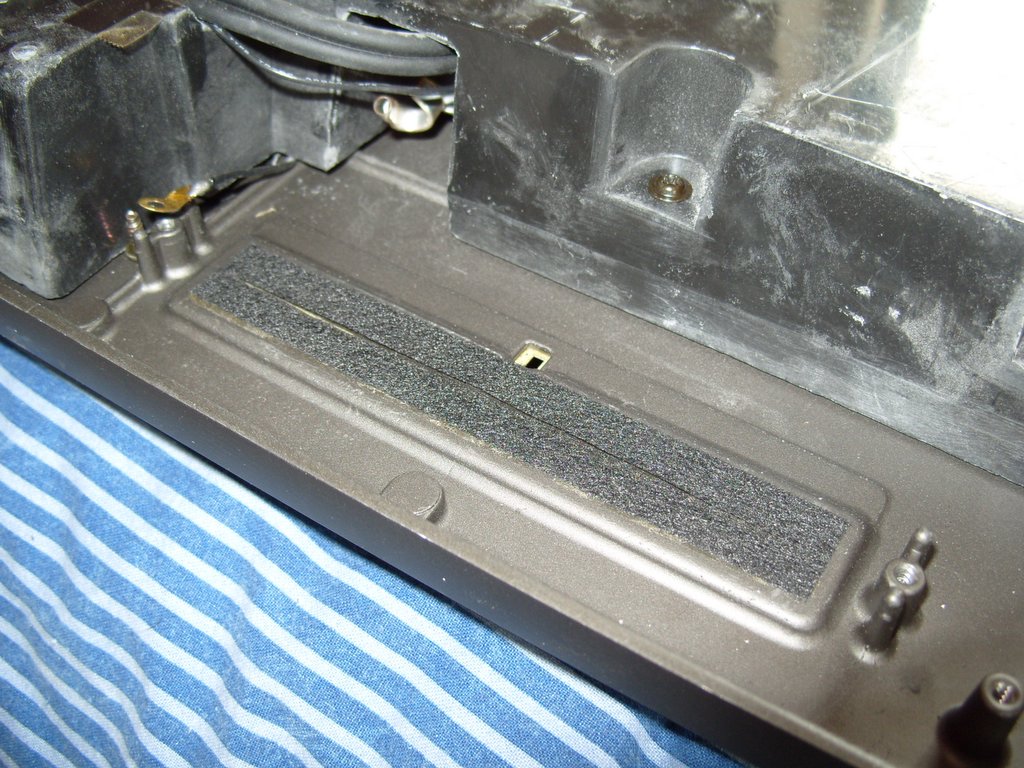
This is very straight forward but I thought I add it anyhow.
Remove the old cloth with a razor. Try to get as much of the glue as possible.
Add the new cloth, you can place the razor in the slit to help aligning it.
Remove the old cloth with a razor. Try to get as much of the glue as possible.
Add the new cloth, you can place the razor in the slit to help aligning it.
Closing Up and Checking Adjustment

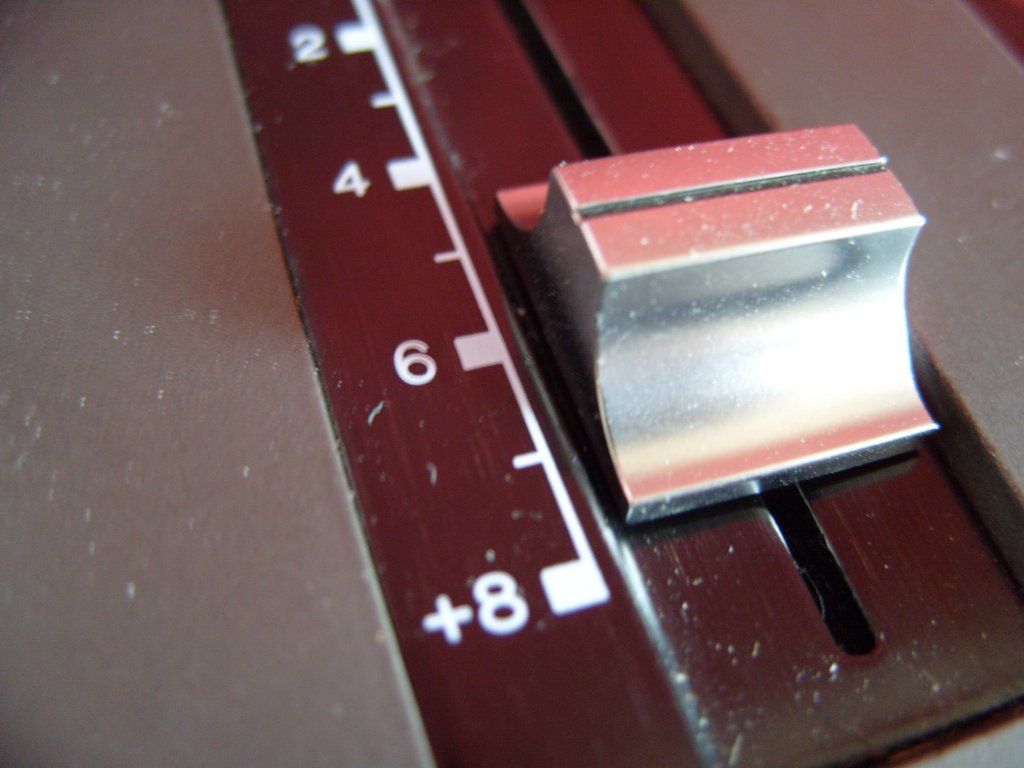
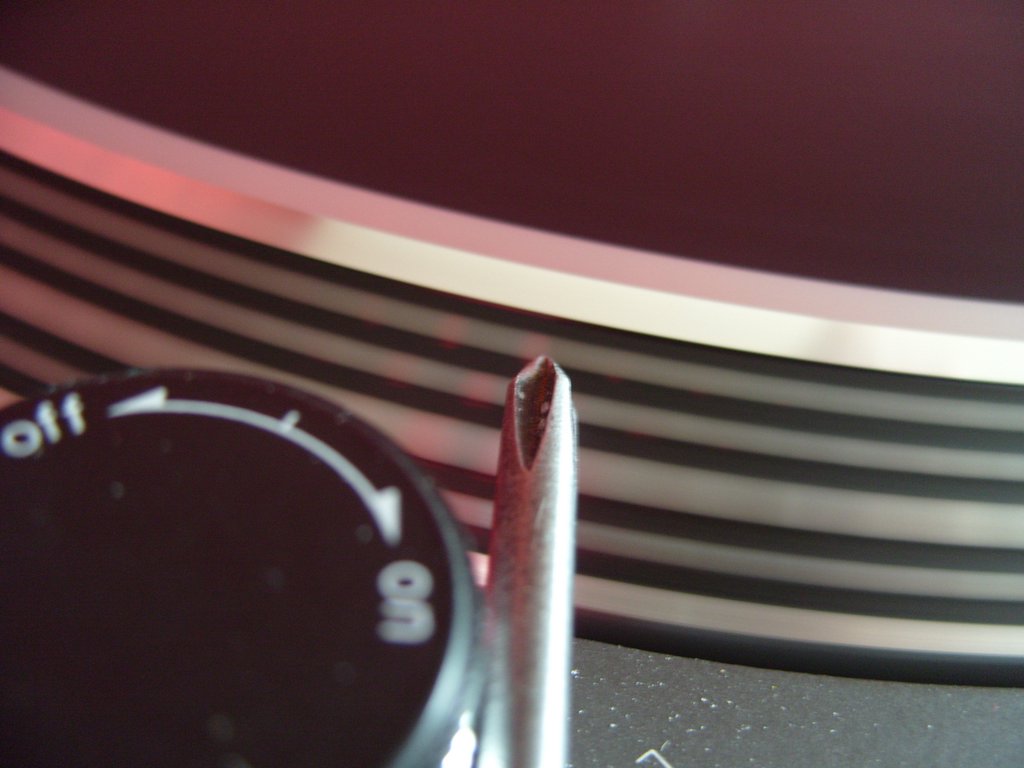
The biggest part is now done. Now we need to check if the pitch needs to be adjusted.
Slide the cable through the hole where it came from earlier. If you want to you can try to replace it in the metallic spiral, I didn't. Replace the pitch slider PCB in the top half of the turntable (be careful so the LED goes through the hole in the lid). Replace the two screws fastening it and remember to attach the small ground cable at the top of the pitch slider.
Replace the bottom. Replace all screws in the correct locations. Do not twist the screws too hard as it is quite easy to destroy the threads on some of them. Replace the feet.
When all screws and feet are back, turn the turntable over. Replace the cover on the top (do not add the screws yet). Replace the platter by placing it over the spindle and pushing it down ever so slightly, it should snap into place.
Ok, the lid and the platter are back in place? Connect the turntable to mains power and turn it on. Place the pitch slider at +6%. Start the platter. Have a look at the dots on the platter near the strobe under the on/off switch. The top row of dots represent +6% pitch.
If the top row of dots stay stationary (it's easier to see this if you place a screwdriver up against the power switch, make sure the screwdriver DOES NOT touch the platter though) you are all good. Please skip the next step and go directly to the end!
If the dots move either right or left slowly you will have to adjust the pitch. Proceed to the next step.
Slide the cable through the hole where it came from earlier. If you want to you can try to replace it in the metallic spiral, I didn't. Replace the pitch slider PCB in the top half of the turntable (be careful so the LED goes through the hole in the lid). Replace the two screws fastening it and remember to attach the small ground cable at the top of the pitch slider.
Replace the bottom. Replace all screws in the correct locations. Do not twist the screws too hard as it is quite easy to destroy the threads on some of them. Replace the feet.
When all screws and feet are back, turn the turntable over. Replace the cover on the top (do not add the screws yet). Replace the platter by placing it over the spindle and pushing it down ever so slightly, it should snap into place.
Ok, the lid and the platter are back in place? Connect the turntable to mains power and turn it on. Place the pitch slider at +6%. Start the platter. Have a look at the dots on the platter near the strobe under the on/off switch. The top row of dots represent +6% pitch.
If the top row of dots stay stationary (it's easier to see this if you place a screwdriver up against the power switch, make sure the screwdriver DOES NOT touch the platter though) you are all good. Please skip the next step and go directly to the end!
If the dots move either right or left slowly you will have to adjust the pitch. Proceed to the next step.
Pitch Slider Adjustment

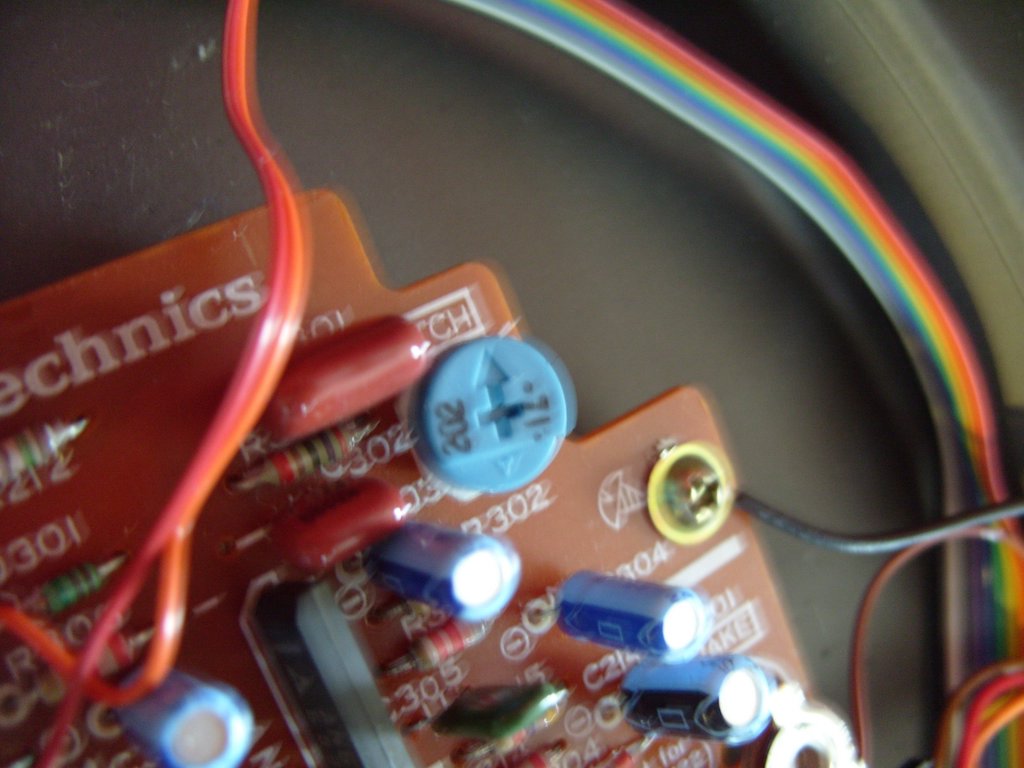

If your dots were stationary you should not be looking at this step, proceed directly to the next one!
Before proceeding, disconnect the turntable from mains power again. DO NOT try to make any adjustment with the mains power connected!
The fine adjustment of the pitch slider is done using a small potentiometer on the main PCB under the platter. The adjustments are made using a phillips head screwdriver. Most likely this pot is in almost the correct position and the adjusments you will have to make are extremely small. We are talking fractions of a milli meter here! This can be quite time consuming.
The procedure is as follows:
1. Disconnect the mains power.
2. Remove the platter.
3. Remove the lid and locate the pot.
4. Make a tiiiiiiny adjustment either left or right.
5. Replace the lid.
6. Replace the platter.
7. Replace the mains power.
8. Turn the turntable on and check the dots.
9. Stationary dots? Congratulations; you are done. Proceed to next step in the instructable. If the dots are moving, go back to step 1.
As it's hard to place the pitch slider at "exactly +6%" you can take this into account. If the dots are moving ever so slightly left or right and you touch the pitch slider and they stop, I would say you are done.
As I understand it there is a more exact way to do this using a frequency counter or similar. I do not know how this is done though. I would think that this method is more than enough for most people.
Before proceeding, disconnect the turntable from mains power again. DO NOT try to make any adjustment with the mains power connected!
The fine adjustment of the pitch slider is done using a small potentiometer on the main PCB under the platter. The adjustments are made using a phillips head screwdriver. Most likely this pot is in almost the correct position and the adjusments you will have to make are extremely small. We are talking fractions of a milli meter here! This can be quite time consuming.
The procedure is as follows:
1. Disconnect the mains power.
2. Remove the platter.
3. Remove the lid and locate the pot.
4. Make a tiiiiiiny adjustment either left or right.
5. Replace the lid.
6. Replace the platter.
7. Replace the mains power.
8. Turn the turntable on and check the dots.
9. Stationary dots? Congratulations; you are done. Proceed to next step in the instructable. If the dots are moving, go back to step 1.
As it's hard to place the pitch slider at "exactly +6%" you can take this into account. If the dots are moving ever so slightly left or right and you touch the pitch slider and they stop, I would say you are done.
As I understand it there is a more exact way to do this using a frequency counter or similar. I do not know how this is done though. I would think that this method is more than enough for most people.
Final Touches



Disconnect mains power again. Remove the platter. Replace the five screws holding the lid in place. Replace the platter. Replace the pickup.
Congratulations! You are done, now give it a test drive. Enjoy your new smooth pitch slider!
Congratulations! You are done, now give it a test drive. Enjoy your new smooth pitch slider!